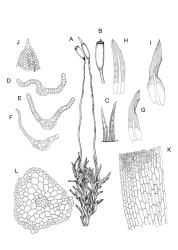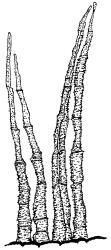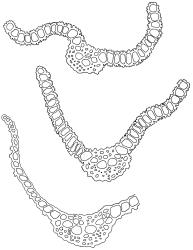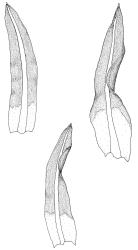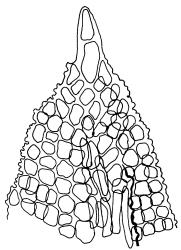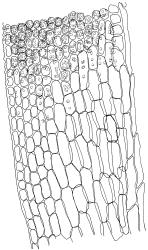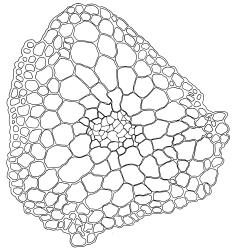- ≡ Syrrhopodon dubius Schwägr., Sp. Musc. Frond. Suppl. 4, tab. 312.b (1842)
- ≡ Didymodon dubius (Schwägr.) Paris, Index Bryol., ed. 2, 2, 68 (1904)
- = Trichostomum binnsii R.Br.bis, Trans. & Proc. New Zealand Inst. 29: 486–487 (1897)
- ≡ Didymodon binnsii (R.Br.bis) Dixon, Bull. New Zealand Inst. 3: 125 (1923)
- ≡ Erythrobarbula binnsii (R.Br.bis) Sainsbury, Rev. Bryol. Lichénol., n.s. 21: 216 (1952)
- ≡ Bryoerythrophyllum binnsii (R.Br.bis) Wijk & Margad., Taxon 8: 71 (1959)
Bryoerythrophyllum jamesonii sensuRatkowsky (1980), Beever et al. (1992) and Fife (1995).
Plants yellow-green above, brick-red below, forming dense tufts. Stems 5–20 mm, central strand present, sclerodermis weakly developed. Leaves spreading when moist, incurved and weakly twisted around stem when dry, 1.0–1.5 mm, lingulate, carinate, acute with a hyaline apiculus; margins recurved below or plane throughout, crenulate-papillose, and occasionally irregularly dentate at the apex; upper laminal cells obscure, subquadrate, firm-walled, pluripapillose with c. 4–6 complex papillae, (6.0–)7.0–12.0(–13.5) × 7.0–9.0(–10.0) µm, becoming longer and with uniseriate, simple papillae towards the leaf base; upper marginal cells ± oblate in 1–2 rows; lower laminal cells conspicuously differentiated, gradually transitioning from upper laminal cells, hyaline, rectangular to long-hexagonal, lax and thin-walled, smooth, with c. 4 rows narrower and firm-walled forming a weak border. Costa stout, failing a few cells below the apex or percurrent; adaxial superficial cells at mid leaf elongate and thick-walled; abaxial superficial cells at mid leaf fusiform to rectangular, papillose; in cross-section with stereids exposed on both faces at mid leaf. Laminal KOH colour reaction orange-red to red.
Reportedly dioicous. Perichaetial leaves longer than vegetative leaves, with bases loosely sheathing the seta, upper portions flexuose when dry. Perigonia bulbiform at apex of male shoot. Setae slender, flexuose, red, 7–10(–15) mm. Capsules subcylindric, sometimes arcuate, pale brown, 0.9–1.0(–2.0) mm. Operculum bluntly rostrate, slightly oblique, ⅓–½ the theca length. Peristome c. 150 µm, pale, of 32 straight, narrow rami (sometimes partially conjoined), nodose, and very weakly spirally ornamented, from a very low basal cylinder. Spores 9–11 µm, smooth.
Magill 1981, fig. 72, 1–10 (as B. jamesonii); Zander 1993, pl. 25, 1–8 (as B. binnsii); Malcolm et al. 2020, p. 497.
Features described for recognition of the genus Bryoerythrophyllum provide guidelines for both species. Shoots of B. dubium are more slender than those of B. recurvirostrum, with leaf margins recurved only below, or plane throughout. Microscopic distinctions in costal cross-section are given in the key.
K; NI: N Auckland, S Auckland, Gisborne, Hawke’s Bay, Wellington (incl. KA); SI: Nelson, Marlborough, Canterbury, Otago; Ch.
Australasian. Mainland Australia* and recorded from Tasmania (as B. jamesonii) by Dalton et al. (1991).
On soil or rock (e.g., basalt, greywacke), exposed or lightly shaded. Associated mosses include Ceratodon purpureus, Fissidens leptocladus, F. megalotis, Hypnum cupressiforme, and Thuidiopsis furfurosa.
Records are known from 10 m (North Cape, N Auckland L.D.) to 1550 m elevation (St Arnaud Range, Nelson L.D.).
The Central American species Bryoerythrophyllum jamesonii (Taylor) Crum has been recorded for N.Z. (e.g., Ratkowsky 1980; Fife 1995; Beever et al. 1992). Comparison with type material of B. jamesonii (Ecuador, Pichincha, W. Jameson s.n. HUH 00258057) shows that N.Z. specimens (including the type of Trichostomum binnsii R.Br.bis) differ in their leaves having fewer marginal teeth (which are confined to near the leaf apex), a conspicuous area of smooth, thin-walled, hyaline cells adjacent to the costa in the leaf base, and the abaxial surface of the costa finely and densely papillose in at least its distal third. N.Z. specimens previously so named are now referred to B. dubium.




